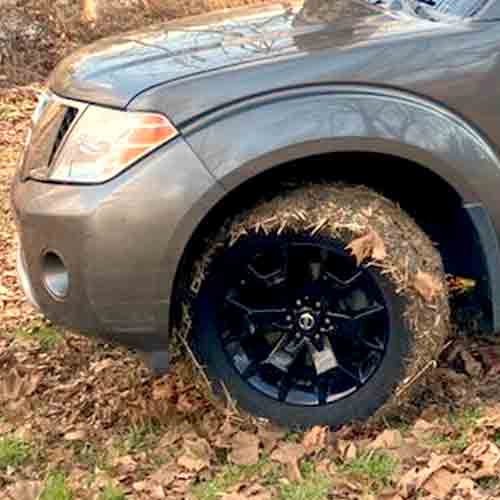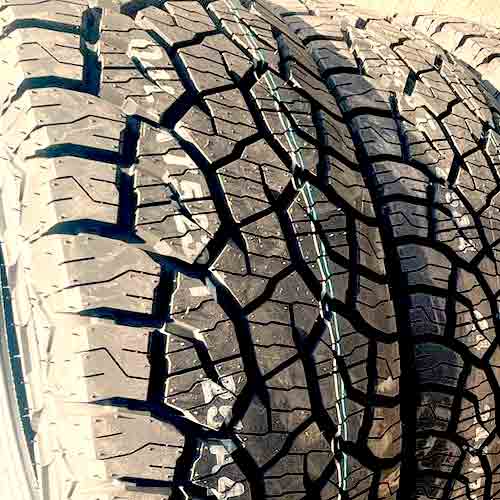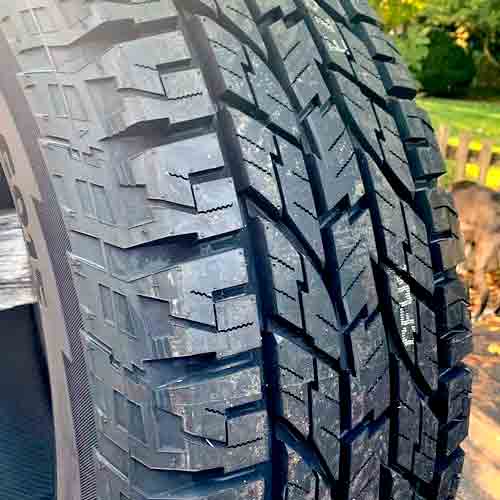Both the Kumho Road Venture AT52 and Yokohama Geolandar G015 A/T offer amazing off-road traction and smooth performance on the road. They may not be what you’d call “aggressive” all-terrain tires, but if you know where they excel, they can be the perfect pick for you. Let me give you a hint!

As a tire engineer, I consider the Kumho Road Venture AT52 a better tire for dry traction, fuel economy and tread life. Whereas the Yokohama Geolandar G015 remains unbeatable in the comfort department. Moreover, the tire also does better in the mud traction department, though lacks to it’s counterpart on rocks and sandy terrains. Both tires have equal winter traction though, and I must say, it really makes sense why both of them have 3 peak mountain snowflake ratings.
Table of Contents
Must Know Sizes Info
The Kumho Road Venture AT52 provides you with 15 to 20 inches rim diameters with following specs:
- Sizes: 15 to 20 inches rims.
- Speed ratings: Q, R, S and T.
- Load ratings: SL to F.
- Weight range: 30 to 63 lbs.
- Tread depth: 13 to 16/32″ (mostly seen with 16/32″).
- Winter ratings: 3PMSF and M+S rated.
- Tread warranty: 50k miles for LT, (55k for P metric).
- Durability: 2 ply sidewalls.
On the other side, the Yokohama Geolandar AT offers following.
- Sizes: 15 to 22 inches wheel diameters.
- Speed Ratings: R, S, T, and H.
- Load Ratings: SL, XL, C, D and E.
- Weight range: 25 to 70 lbs.
- Tread depth range: 12 to 18/32″.
- Warranty: 50k (LT sizes), 60k (non LT).
- Winter ratings: 3PMSF and M+S.
- Durability: 2 ply sidewalls.
Tread Structure
The Kumho Road Venture AT52 features a very on-road oriented design, let me explain how.

Starting things form the middle, the tire features U shaped (central most) rib which together look like a “S”.
These lugs are bigger and more closed up longitudinally, so they can provide good enough on-road directional grip on dry, where the full depth interlocking sipes, seen on them deliver wet traction.
The surrounding ribs are more spacious, but carry similar features.
Together all ribs in the middle, make 4 very tough passing longitudinal grooves, where the outer ones separate the shoulder ribs.
Speaking of which, the shoulders are less aggressive, having rectilinear siping, and less no. of biters. And their outer edges are not properly staggered as well, though they do make stepped edges, and thick enough N shaped sidewall lugs.
On the other side, the Yokohama Geolandar AT is also very streamlined towards roads.

This tire clearly makes 5 longitudinal channels where the central most rib is slightly less wide compared to others.
All these lugs (all over the tread), sit on secondary continuous running rubber layers underneath, supplying pavement stability.
And where it gives such great on-road traction, the in groove biters of “thunder-lightning” shapes combined with interlocking sipes provide ample traction on rugged terrains as well.
Same goes for shoulders. They are made stable with ridge placed in between the lateral grooves, and foundational supports underneath, and at the same time with sharp notches facing the middle, and saw-toothed edges on the outside, they supply traction on all types of rugged terrains.
Though I really do miss the sidewalls on this tire, as they are not thick enough.
Off Road Performance
Off-road, there are mainly three different kind of terrains, let me put them one by one, explaining how both tires performed in each of them (below).
Mud
All terrain tires have a very limited performance on muddy tracks, as their tread doesn’t give enough room for the thick mud to leave out in time.
Though in lighter terrains, you can expect some kind of traction, and out of both, I’d have to go with Yokohama Geolandar A/T.
Although both tires have longitudinally arranged lugs, disallowing lateral evacuation, the Geolandar G015 comes with slighter wider shoulder grooves, still allowing for better mud-flow.
The Kumho AT52 on the other hand, is more susceptible of mud packing, as it’s interlocking central structure doesn’t want to let go off mud that easy.
On Sand
The key to driving successfully on sand is to reduce tire air pressure, as it enhances the overall footprint with the sand.
Though there are other features at play here too, like weight and sidewalls, and considering them, it can be seen why overall performance is better on Kumho.
Kumho AT52 basically expands its sidewall lugs enhancing its overall footprint (with lowered air pressure).
Whereas the Geolandar AT although has softer compound which molds better with sand, it comes out with sharper sides, which is more prone to sinking.
And let me tell you digging is the worst for the traction.
Rocky Terrains
To drive on rocks with confidence, you need a tire with pliable blocks providing strong grip form multiple angles, and a robust sidewall construction to defend against sharp encounters.
Although both tires offer a lot of biters form the middle, the Kumho Road Venture with its serrated shoulders, and sidewall lugs still provide better overall traction.
On the tire’s outer edges, each of its shoulder lugs is staggered upon itself and that combined with thick sidewall lugs, the tire offers better climbing traction with lowered air pressure.
Note: I don’t recommend them both for aggressive rocky terrains, though in case of lighter trails, these all terrain tires are worth it.
On Road Comfort
Comfort of the ride, depends on two major factors, noise and the feel of the ride, and in both the Yokohama Geolandar G015 is one of the best.
It offers a very pliable tread compound, and it’s spirally wound cap ply is also very soaking. Both of them settle down the imperfections of the road in a very effective way.
Moreover, the tire also features a lot of tread depth, which means there’s more rubber between the road, and the vehicle. So bumps are dampened down before it reaches the drivers seat.
In terms of noise, the tire offers air blocker between the shoulders and superior pitch sequencing technology, which reduces down the noise levels very efficiently.
Noise is mostly made when air strikes the tread walls (coming in mostly through the outer area of the tread). I covered it up in more detail here: https://tiredriver.com/are-all-terrain-tires-noisy/
The Kumho Road Venture AT52 in comparison, comes with a stiffer tread compound with shallower tread depth (on average), and so it can’t settle down the bumps as effectively as its counterpart.
Though it’s noise dampening abilities are impressive enough too, as it also features Whisper Grooves technology (a term used to Cooper tires).
This technology simply put means, placing rubber connectors between the shoulder lugs, to prevents air from flowing in and out of the tread easily.
Highway Capabilities
The overall highway traction is seen better on the Kumho Road Venture AT52 and it really makes sense.
The tire comes with a more rigid rubber compound (relatively), and forms a better rubber to road connection with wider central running rib (explained in the tread section above). This yields shorter braking distances on highways.
Moreover, its stiffer tread compound also ensures, lugs don’t bend as much with the tire turning sharply or braking suddenly (for example), generating better balance between over and under steering.
The Yokohama Geolandar A/T on the other hand, has tread blocks with rubber eaten away with a lot of in-groove notches, so it lacks overall.
Moreover, its relatively softer composition, enforces its blocks to flex a lot more, during tire’s maneuverability, and this causes the tire to over and under steer, reducing it’s handling abilities and that renders slower steering feedback.
In other words, it slows you down, relatively speaking.
Wet Performance
The wet grip is a more tricky subject, as it depends on two things, sipes, and flexibility of the tread. Both of these work in tandem to remove water out of the tread.
Basically most of the water gets escaped out, through the tread voids, or grooves, while the remaining (smaller amount) of water is cleared off with sipes, which suck them in their slits, by creating suction with “flexing”.
That’s why out of both tires, you see less overall slippage on Yokohama Geolandar G015. The tire comes with a lot of siping slits and notches to wipe off water particles, and they also happen to have a lot more pliability, thanks to the tire’s malleable tread compound.
The Kumho AT52 on the other hand, although also comes with numerous sipes, its stiffer tread compound doesn’t allow those sipes to effectively contract/expand, and suck water particles in that effectively, limiting overall wet gripping.
Though just like the Geolandar, Kumho also offers good enough resistance to hydroplaning, no doubt about that. During my testing with these tires, both of them showed me with similar curved and straight aqua float speeds.
Fuel Usage
Fuel is largely associated with the tire’s weight, and tread structure.
Having said that, where the harder tread composition of Kumho AT52 does not allow it to have better wet traction, it really enhances its fuel economy, as it’s tread blocks don’t flex too much and reserves energy in to rolling of the tire.
Moreover, it’s structure is also overall lighter, so its lugs aren’t pushed that much against the road, resulting in lower rolling resistance values.
In comparison the Yokohama G015 with sticky material and a lot of in-groove notches doesn’t want to let go off the surface that easy, and so it generates larger rolling resistance values, and with it compromised fuel efficiency.
Snow Grip
For winter performance, I tested both these tires on two types of terrains, on-road snow, and deeper terrains. And let me tell you, I have to rate them both equal here.
Both tires carry 3PMSF and M+S ratings, and they deserve it.
Both tires features a lot of in groove biters grabbing snow particles within and forming snow to snow contact (which yields greater grip, compared to tread/rubber contact).
And both of them have a new gen thermal adaptive rubber, which stays malleable even with extreme freezing temperatures, so the biters stay flexible to grip in.
Take Home Points
Kumho Road Venture AT52 although features a better dry grip, it lacks to its competitor on wet roads.
Moreover, the tire is a better choice if you are considering fuel and tread life, as it generates lower rolling resistance values.
On the other hand, the Yokohama Geolandar G015 is one of the best tires out there (in A/T category), when it comes to comfort. This is mainly due to its softer compound, which is also great on muddy terrains.
Though it can’t keep up as much on sand and rocks, relatively speaking.
This is not a technical comment, but more of an editing one.
Do you not have anyone doing a proofread or run it through an editing software such as Grammarly? I saw at least 10 what I assume were typos of word choice, usually of letter reversals like form instead of from.
And don’t give the excuse that you are a tire engineer, not an English teacher. I am sure it would not appear like this in print. Online should be just as accurate.
Thank you for bringing this to my attention, Jim. I will fix it soon.